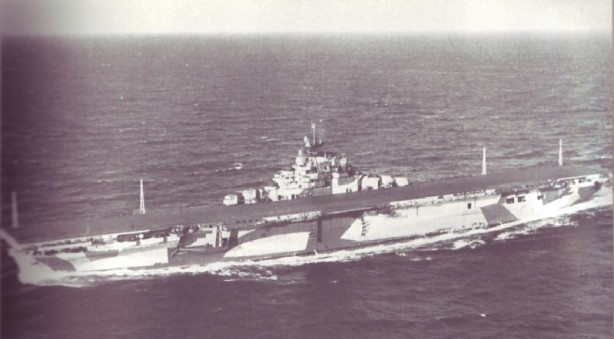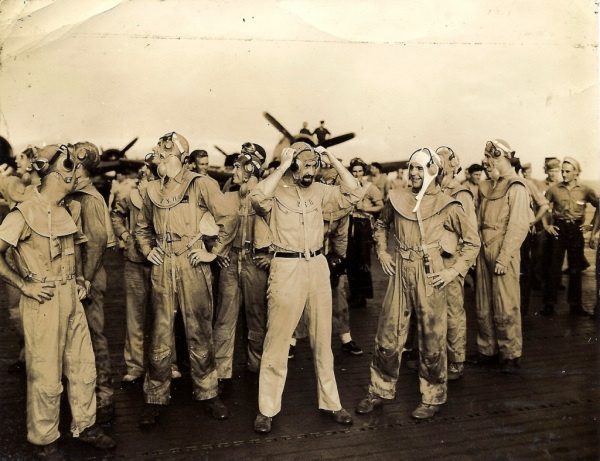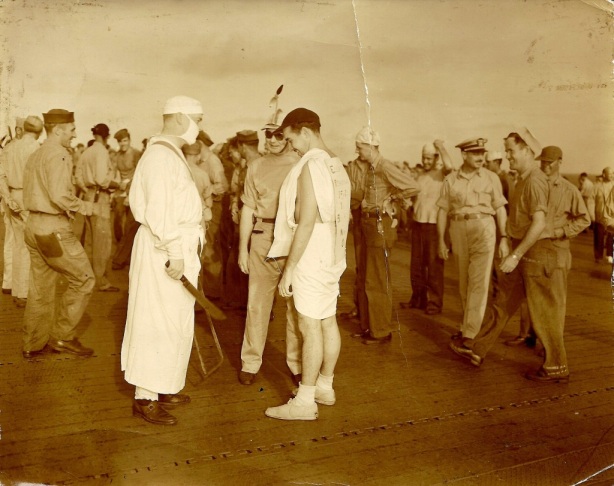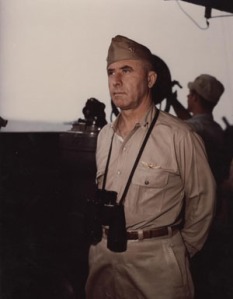In my previous posts, I wrote that my father, Seaman First Class, John T. Ryan enlisted in October 1942 and was received on board of USS Hornet (CV-12) on December 10, 1943. At this point I have a whole in the story that will require more research which probably includes ordering Naval records. I know when he enlisted from his discharge papers and I know when he boarded the ship from the US Navy WWII Muster Rolls. I don’t know when and where he reported to boot camp and what else he experienced between October 1942 and December 10, 1943. SEE UPDATE BELOW
Until I have my father’s information, here is a little about WWII Navy Boot Camp from the following source:
http://www.astralpublishing.com/wwii-navy-boot-camps.html
WORLD WAR II NAVY BOOT CAMPS
At the beginning of World War II the United States Navy had four Boot Camps at San Diego, CA; Bainbridge, MD; Newport, RI; and Great Lakes, IL. During the war they added three more camps at Norfolk, VA; Sampson, NY; and Farragut, ID.Items Issued to an Enlisted Man In Boot Camp On entering Boot Camp during the World War II era, besides getting his shots and a buzz haircut, a Navy recruit discarded his civilian attire and possessions. He boxed his shirt, underwear, and pegged pants and shipped them home. Then after he stood shivering in the nude in a large room with hundreds of other young men, Navy Supply Clerks tossed at him the uniforms and other gear he would use during his period of enlistment. They piled on his arms uniforms, with little attention to size, that the recruit learned wear, not always the proper way at first. The Navy then gave him his sleeping gear. In the tradition of the old navy they issued him a hammock with a mattress, two mattress covers (sailors called them fart sacks), one pillow, two pillow covers, and two blankets. The Boot needed a place to store these items, so one of the first items issued to him was his Sea Bag. This cylindrical canvas sack of 26″ x 36″ had grommets on top through which the man wove a line to use as a draw string to close the bag and to hang it from a rack. As with everything else he got, he stenciled his name on the side of the bag. This bag was his and his only. It was his entire and unique identity as an individual among the mass of other men. When traveling, a sailor rolled his mattress and sleeping gear inside the hammock which he then wrapped around and secured to his sea bag. This pack he slung up on a shoulder and marched off with all he owned. Before rolling his mattress, however, a sailor laid out his bedding items on the flattened mattress in a specific order according to regulations.
Then the Navy issued the Boot his bible,The Bluejackets’ Manual. This book contained all the Boot would need to know to become a sailor and handle himself like one at his future stations either ashore or afloat. Training Program In Boot Camp Up and at em, drop em and grab em, fire drill, scrub down that deck, inspection, move it Boot. Now. I ain’t your mommy asking you. It’s me. I’m telling you.
These and other commands the Chief Petty Officer assigned to a Boot company shouted mostly in the middle of the night after a hard, tiring, long, ten hour day of marching, calisthenics, scrubbing clothes, rifle-over-your-head drills, pulling oars in a boat, loading heavy shells in a 5″ gun, and other training activities. The obvious reason for harassing the Boots was to get them accustomed to discipline, to respond to disagreeable orders, to function with little sleep, and probably to give the Chief his kicks, Whatever. It worked.
*****UPDATE*****
Through completing a form and as I am a direct descendant of the veteran, I was able to obtain a copy of his US Navy file. I have gained a little more information by getting this file. As stated before, my father, John Thomas Ryan enlisted in the United State Navy on October 28, 1942. This is actually the date that he reported to the Naval Recruitment Center in Philadelphia. On October 30, 1942 he was transferred to USNTS, Bainbridge, Maryland. His rank was A.S., V-6. (Apprentice Seaman).
SEAMAN–Performs ordinary deck duties in connection with the upkeep and operations of a ship. Stands watch as look-out, telephone talker, messenger, or simillar duty. Member of gun crew.
V-6 — Enlisted men required for mobilization in addition to other classes of Volunteer Reserve.
According to my research, this training center had been active only a month when my father arrived. His commanding officer upon arrival was C.F. Russel, Captain USN.
United States Naval Training Center, Bainbridge (USNTC Bainbridge) was the U.S. Navy Training Center at Port Deposit, Maryland, on the bluffs of the northeast bank of the Susquehanna River. It was active from 1942 to 1976 under the Commander of the Fifth Naval District, based in Norfolk, Virginia.
Located on the appropriated campus of the Tome School for boys, the training center sat between various important naval centers of World War II: about 35 miles (56 km) northeast of Baltimore, Maryland, and 75 miles (121 km) from Washington, D.C., and Philadelphia, Pennsylvania. It was reached via Maryland Route 222, about halfway between US 1 and US 40.
The center was activated on October 1, 1942, and the first batch of recruits arrived 10 days later to begin “boot camp” training and indoctrination. They came in busloads from transportation collection points at Havre de Grace and Perryville, Maryland. The recruits were given a battery of tests to determine their educational and skill levels, then trained in indoctrination, ordnance and gunnery, seamanship, fire fighting, physical training, and military drill.
Halfway through boot camp, recruits had a “service week”, which generally included kitchen duty, peeling potatoes, mopping, picking up cigarette butts, etc. Recruits with desirable skills, such as typing, could end up on an office typewriter rather than in a kitchen.
Recruits were also trained in shipboard duties aboard the R.T.S. Commodore, a relatively large “ship” built on dry land. The trainer was equipped with most of the facilities found on a real ship, including deck guns, pilot house, davits with whaleboats, and mooring lines fastened to earth-bound bollards, so that crew members could learn casting off hawsers and other lines connecting the ship to its dock.
By the end of World War II, the center had trained 244,277 recruits who transferred to various ships and stations throughout the world.
On January 26, 1943 while at the USNTS, Bainbridge, MD, John Thomas Ryan was promoted to Seaman Second Class (S2c, V6).
On February 22, 1943 when my father completed training in Bainbridge, Maryland, he was transferred to the Naval Shipyard in Long Beach, California.
The life of the Long Beach Naval Shipyard began in 1940 when, for $1, the Navy acquired 104 acres of oceanfront on Terminal Island from the city of Long Beach. Later, landfills and dredging increased the shipyard site to 396 acres. It was located at Terminal Island between Long Beach and San Pedro about 23 miles south of Los Angeles International Airport. It opened in February 1943 with 300 workers. It was established to repair and refurbish U.S. naval vessels. During World War II, the naval dry docks did routine and battle damage repairs to tankers, cargo ships, troop transports, destroyers and cruisers. It also served as a depot for fuel and supplies for U.S. Navy ships on their way to war or deployment.
On March 20, 1943, Seaman Second Class, John Thomas Ryan was received on board the USS Dashiell (DD659). According to my research, this would be on the ship’s commissioning date. According to the US Navy WWII Muster Rolls, he remained on board through October 17, 1943.
Although my father was only on board for a part of the USS Dashiell (DD-659) war history, here is a little about her. You can read more about the ship at this link http://en.wikipedia.org/wiki/USS_Dashiell_%28DD-659%29 or other internet sources.
The USS Dashiell (DD-659) was a Fletcher-class destroyer of the United States Navy, named for Robert B. Dashiell (1860–1899). Dashiell was launched 6 February 1943 by Federal Shipbuilding and Dry Dock Co., Kearny, N.J.. sponsored by Mrs. R. B. Dashiell, widow of Assistant Naval Constructor Dashiell; and commissioned 20 March 1943, Commander J. B. McLean in command.
In World War II, the USS Dashiell (DD-659) arrived at Pearl Harbor 24 July 1943 to join the Fast Carrier Task Forces for the raids on Marcus Island of 31 August to 1 September; Tarawa, 18–20 September; and Wake Island, 5–6 October. Arriving at Efate, New Hebrides, 5 November, she prepared for the invasion of the Gilberts and was one of the first to enter the lagoon in the assault on Tarawa 20 November. She passed into the lagoon under heavy enemy fire, took up position just off Tarawa’s reef, and opened return fire on shore batteries, enemy strong points and an ammunition dump to aid the troops ashore for three days. Following the cessation of hostilities on Tarawa, the Dashiell was sent to the US’ west coast for an overhaul.
On October 17, 1943, my father was transferred to C.O. RecSta, Pearl Harbor, T.H. FFT. I don’t know what these abbreviations are but according to the papers from his file, he was granted 8 days leave in accordance with BuPers c/L No. 167-43 and additional orders to report to Recship at San Francisco, California which he did on November 7, 1943.
How did enlisted personnel get from one place to another during the war. Nothing in the papers says how he traveled from Pearl Harbor, Hawaii to San Franscisco, California. Is it the reason for the leave? Did the men have to find a means of transport? If anyone reading this blog has the answer, I would like to know.
On November 19, 1943, my father reported to the station at Newport News, Virginia. Again, how did he get there, clear across the country? Was it the Recship mentioned above. Could a ship get from California, down through the Panama Canal and up to Virginia in twelve days?
*****END OF THE UPDATE*****
Now I will begin writing the details of the aircraft carriers activity in WWII. Since my story of war will be more facts than personal accounts, I thought I would first add some insight into the life aboard an aircraft carrier during WWII and my search of the internet happened upon the most insightful film on the subject. I was blown away by this film so I feel it can tell the story I wanted to tell so much better. If you have about 100 minutes, I highly recommend watching the Fighting Lady which is available at no cost.
http://archive.org/details/FightingLady
About the film:
“The Fighting Lady,” directed by William Wyler, provides a portrait of life on a World War II aircraft carrier, a vessel that is “enormous, wonderful, and strange to us.” After profiling the various activities of the soldiers’ day and following the ship’s voyage through the Panama Canal, the film takes the audience through a litany of actual combat engagements. The Fighting Lady participates in a strike on the Marcus Islands, then defends itself against a surprise nighttime raid by Japanese fighters. Some of the photography comes from cameras set up in the cockpits of American planes, showing first hand what it’s like to be diving through enemy anti-aircraft fire. The film culminates in a major confrontation with the Imperial Japanese Battle Fleet. In this massive operation, later dubbed the “Marianas Turkey Shoot,” American pilots downed almost four hundred Japanese Zeros, while incurring only twenty-two losses themselves.
It was called the Fighting Lady to keep the true identity of the carrier a secret. When secrecy was no longer necessary, it was revealed that it was the USS Yorktown (CV-10). She is also an Essex Class carrier (most were) so I think it is probably a pretty good match to my father’s life during the war. I hope you enjoy watching it as much as I did.
The First Captain (November 29, 1943 – May 29, 1944)
 According to Wikipedia, Miles Rutherford Browning (April 10, 1897 – September 29, 1954) was an officer in the United States Navy in the Atlantic during World War I and in the Pacific during World War II. A pioneer in the development of aircraft carrier combat operations concepts, he is noted for his aggressive aerial warfare tactics as a captain on the USS Enterprise during World War II. His citation for the Distinguished Service Medal states: “His judicious planning and brilliant execution was largely responsible for the rout of the enemy Japanese fleet in the Battle of Midway.” He is the grandfather of actor Chevy Chase.
According to Wikipedia, Miles Rutherford Browning (April 10, 1897 – September 29, 1954) was an officer in the United States Navy in the Atlantic during World War I and in the Pacific during World War II. A pioneer in the development of aircraft carrier combat operations concepts, he is noted for his aggressive aerial warfare tactics as a captain on the USS Enterprise during World War II. His citation for the Distinguished Service Medal states: “His judicious planning and brilliant execution was largely responsible for the rout of the enemy Japanese fleet in the Battle of Midway.” He is the grandfather of actor Chevy Chase.
In the spring of 1944, during a nighttime showing of a film on Hornet’s hangar deck, someone discharged a CO2 canister and triggered a stampede. In the chaos, two sailors fell overboard; one of them drowned. A board of investigation was ordered, which criticized Browning’s command. The ensuing ruin of his career, “one of the great wastes to the American prosecution of the war,” resulted, ironically, from nothing having to do with combat. Browning was removed from command of Hornet in May 1944 and reassigned to the Command and General Staff College at Fort Leavenworth, Kansas, where he taught carrier battle tactics during the final months of the war. Halsey was given command of the carrier-oriented Third Fleet during 1944-1945, but with his old chief of staff tossed onto the beach, he made grave mistakes that Browning might well have been able to help prevent.
Browning toured Japan in 1949, and stated that radiation damage from the atomic bombs was a “myth”. He pointed to gardens and a number of tall chimneys left standing in Hiroshima and Nagasaki as proof that there were no long-term effects of the blasts.
Browning retired from active duty on January 1, 1947, just short of his 50th birthday, and was retroactively promoted to rear admiral (upper half). He was appointed New Hampshire’s Civil Defense Director in 1950, where he devised a plan wherein 500,000 displaced residents of Boston could be housed in New Hampshire private homes in the event of disaster. Browning resigned from this post in 1952.
On September 29, 1954, Browning died of systemic lupus erythematosus at Chelsea Naval Hospital in Boston. He was buried on October 6, 1954 at Arlington National Cemetery.
January 1, 1944 – First CAG 15 landing on Hornet by Commander Bill Drane. I am sure this picture doesn’t specifically match this item in the ship’s log, however it is the USS Hornet CV-12 flight deck and it is 1944. The source was a member of the Warbird Information Exchange http://warbirdinformationexchange.org/phpBB3/viewtopic.php?p=496931

Deck crewman aboard USS Hornet CV-12 disengages tailhook from the arresting gear while another chases stray ordnance that came loose during landing

USS Hornet (CV-12) underway in January 1944 during her shakedown in the Atlantic, before Air Group 15 came aboard. She is wearing Measure 33, Design 3A camouflage. There are only four radio masts on the starboard side of the flight deck, and the hangar catapult outrigger is in the stowed position. In place of a third Mk 37 director, a 40-mm quad mount was fitted at the same level as the flight deck. Note the hull number on the flight deck is unusually painted facing “the other” way — this was corrected before she entered combat. http://www.navsource.org/archives/02/12.htm
From the War Diary found on the website Fold3:
The original plans for the Hornet’s shakedown would have taken her to Trinidad over a period of four weeks. Instead the ship had a two weeks shakedown cruise to Bermuda and back. During these two weeks flight operations were conducted and also exercising in fueling from taker and fueling destroyers. Other miscellaneous drills were conducted. The reason for this shortened shakedown cruise was to rush the Hornet into service with the Pacific Fleet.
February 1944 – Transited Panama Canal for the west coast. There is great footage of a carrier transiting through the canal in the film I spoke about earlier. The picture below is an aircraft carrier passing through the Panama Canal; however which carrier was not listed in the source.
From the War Diary found on the website Fold3:
Enroute from Norfolk, Va. to San Diego, California, Air Group Fifteen was disembarked along with its personnel and wrecked airplanes. The ship then proceeded to the Norfolk Navy Yard for post-shakedown availability. Air Group Fifteen embarked on 14 February, 1944 and the ship got underway enroute to Cristobal, Canal Zone. The Hornet transited the Panama Canal and reported for duty to the Commander and Chief, U.S. Pacific Fleet. Captain Browning was designated as Commander Task Group 12.1. The run from the Canal to San Diego was without incident. The ship left San Diego on 29 February, loaded to capacity with Marine Fliers, ground personnel, and Marine fighter planes.
March 4. 1944 – Arrived Pearl Harbor. Air Group 2 replaced Air Group 15. USS Hornet joins Task Force 58.
Task Force 58 (later renamed Task Force 38) – The Fast Carrier Task Force was the main striking force of the United States Navy in the Pacific Ocean theatre of World War II from January 1944 through the end of the war in August of 1945. The task force was made up of four separate task groups. Each task group was built around three to four aircraft carriers and their supporting vessels. The support vessels were screening destroyers, cruisers, and the newly built and faster battleships.

This photo was taken on March 4, 1944 as Hornet was tying up to the mooring at Fox 9 Ford Island, Pearl Harbor with Air Group 15 on the flight deck. The photo was taken from Essex (CV-9) who would soon be taking Air Group 15 aboard while Hornet would take Air Group 2 into her first combat with the Japanese. http://www.navsource.org/archives/02/12.htm

A close-up of Hornet’s hangar deck catapult with Air Group 2 on the flight deck; 1944. http://www.navsource.org/archives/02/12.htm
March 18/25, 1944 – Crossing the Line. According to the website http://www.navsource.org/archives/02/12.htm, the USS Hornet CV-12 crossed the Equator for the first time on March 25, 1944. This card in my father’s papers has it as March 18, 1944.
This series of photographs from http://www.navsource.org/archives/02/12.htm were taken on board during a “Crossing the Line” ceremony (either the Equator or the International Date Line, or possibly both) in 1944. The photographs were taken by Photographer’s Mate 2/Class Paul D. Guttman. He happened to be on board the Hornet when she crossed both lines. There were separate initiation ceremonies so it is possible these photographs are from two different events. These pictures are quite humorous and I can understand the need to blow off steam especially knowing what these men will face in the future.
From the War Diary found on the website Fold3:
The new Hornet arrived at Pearl Harbor on 4 March. Again preparations were rushed. Air Group Fifteen, which had been with the ship from the beginning was replaced by Air Group Two. Two short training cruises off Pearl Harbor were successfully carried out, and †he ship left for Majuro Atoll, Marshall Islands on 16 March to report to the Fifth Fleet. On arriving at the atoll practically the entire active Pacific Fleet was found assembled and the Hornet became part of Task Force 58, assigned to the Task Group under Admiral Montgomery.
Admiral Clark, Commander Carrier Division Thirteen, had brought her from Pearl Harbor, and continued to make the ship his Flagship, but did not take tactical command of a Carrier Group until after the first operation.
The first operation included strikes and mine-laying at Palau, Caroline Islands and Woleai. Palau, at that time seemed deep within enemy waters. The long run south and westerly, skirting the coast of New Guinea, was uneventful except for occasional enemy snoopers, and at Palau, air opposition consisted of only a few enemy fighters and torpedo planes. Mines were successfully laid; all enemy planes were destroyed and much damage was done to the ground installations in strikes on the 30th and 31st of March. The ship drew her first enemy blood on this operation, beginning with a Betty destroyed by her Combat Air Patrol (CAP) on 29 March. A total of five enemy airborne planes were destroyed during the remainder of the operation.
What is a Betty? The Allies had their own names for Japanese aircraft. The Betty was the Mitsubishi G4M (or “Type 1 land-based attack aircraft”) was the main twin-engine, land-based bomber used by the Imperial Japanese Navy Air Service in World War II.
In my next post, I will pick up again in March 1944 where according to the ship’s log, the USS Hornet (CV-12) began to face the enemy.

























